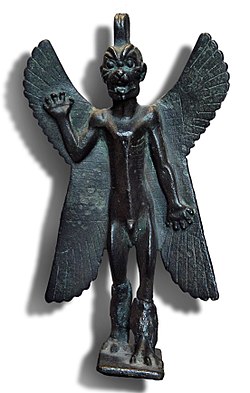Pazuzu

| Part of a series on |
| Ancient Mesopotamian religion |
|---|
 |
|
|
In ancient Mesopotamian religion, Pazuzu (Akkadian: 𒀭𒅆𒊒𒍪𒍪 Dpà.zu.zu; also called Fazuzu or Pazuza)[1] was the king of the demons of the wind, brother of Humbaba and son of the god Hanbi. He also represented the southwestern wind, the bearer of storms and drought.
Iconography
Pazuzu is often depicted as a combination of diverse animal and human parts. He has the body of a man, the head of a lion or dog, talons of an eagle, two pairs of wings, and a scorpion's tail. He has his right hand up and left hand down.
Mythology
Pazuzu is the demon of the southwest wind known for bringing famine during dry seasons, and locusts during rainy seasons. Pazuzu was invoked in apotropaic amulets, which combat the powers of his rival,[2] the malicious goddess Lamashtu, who was believed to cause harm to mother and child during childbirth. Although Pazuzu is, himself, considered to be an evil spirit, he drives and frightens away other evil spirits, therefore protecting humans against plagues and misfortunes.
In modern (pop) culture
- In the 1971 novel The Exorcist and the film based on the novel, Pazuzu is supposedly the evil spirit that possesses the young girl Regan MacNeil. He reappears in the 1977 sequel Exorcist II: The Heretic. In this film, Pazuzu is both named as the demon antagonist of Regan MacNeil and the unwitting helper of Father Philip Lamont (played by Richard Burton), as he seeks to finally free Regan from his hold.[clarification needed]
- Pazuzu appears on the album cover of the Gorillaz compilation album D-Sides, as a statue in front of the band's former recording studio, in the music videos for the band's songs "Dare" and "Rockit".
- Pazuzu (Black Rain) is a track on The Nefilim's 1996 album Zoon.[3]
- Pazuzu is mentioned in the Simon Necronomicon, a publication of Avon Books that purports to document incantations to invoke "incredible things, beings, and monsters into visible form". He is described therein as "Lord of all fevers and plagues, grinning Dark Angel of the Four Wings, horned, with rotting genitalia," and as the "brother of HUMWAWA". The book claims that he is among the most fearsome of all entities, stating in part: "It is the able magician indeed who can remove PAZUZU once he has laid hold of a man, for PAZUZU lays hold unto death."[4] Although the book makes the claim that Pazuzu (like all entities listed therein) was of Sumerian origin, critics John Wisdom Gonce III and Daniel Harms document the erroneous nature of such a claim, stating: "Likewise, the demon Pazuzu does not appear in myth until Assyria's rise in the first millennium B.C., long after Sumer's prime ... Thus the beings of the Simon Necronomicon bear little resemblance to either Sumerian myth or Lovecraftian fiction."[5]
- Pazuzu is the demon that allegedly haunts Adèle Blanc-Sec in Tardi's graphic novel The Demon of the Eiffel Tower (Le Démon de la tour Eiffel, 1976). Pazuzu also appears in "Mummies on Parade" ("Momies en folie", 1978).[6]
- Pazuzu is featured in the 2014-15 NBC television series Constantine in a two-part episode 'The Saint of Last Resorts'. The protagonist, John Constantine, summons Pazuzu to combat Lamashtu, the primary antagonist of the first part, and later willingly allows Pazuzu to possess him to save himself from another powerful demon. However, Pazuzu has no wish to leave his new host, and emerges whenever Constantine is in danger, causing the deaths of at least eight dangerous gangbangers. Luckily, Constantine's ally Anne-Marie is able to exorcise Pazuzu by the end of the second part.
See also
References
- ^ Lambert, Wilfred George (1970). "Inscribed Pazuzu Heads from Babylon". Forschungen und Berichte. 12: 41–T4. doi:10.2307/3880639.
- ^ "Statuette of the demon Pazuzu with an inscription". Louvre website. Archived from the original on 2009-06-28. Retrieved 2010-05-18.
- ^ "Zoon - Nefilim | Songs, Reviews, Credits | AllMusic". AllMusic. Retrieved 14 May 2017.
- ^ NECRONOMICON, 1977 Avon Books, ISBN 0380751925
- ^ Harms, Daniel; Wisdom Gonce, III, John. The Necronomicon Files: The Truth Behind Lovecraft's Legend.
- ^ "Aventures extraordinaires d'Adèle Blanc-Sec, Les", BD, Scénario.
